Commercial Law Assignment: Baby's R Us, Negligence, and ACL Issues
VerifiedAdded on 2022/11/11
|6
|1917
|497
Report
AI Summary
This report addresses a commercial law assignment concerning the liability of Baby's R Us for a defective baby cot. The first issue examines whether Baby's R Us is liable to Rahul and Priya under the law of tort, specifically negligence. The analysis covers the elements of negligence: duty of care, breach of duty, and resultant damage, referencing relevant case law such as Donoghue v. Stevenson. The application of law to facts determines that Baby's R Us is liable for the injury to the child, but not Priya's shock. The second issue explores whether Rahul and Priya can sue under Part 3-5 of the Australian Consumer Law (ACL). The report identifies Rahul as a consumer and assesses the potential for a claim against the seller, importer, or manufacturer, highlighting breaches of ACL sections 51, 54, and 55. The conclusion finds that Baby's R Us can be sued by Rahul due to the cot's failure to meet consumer guarantees. The report provides a detailed legal analysis, applying relevant legislation and case law to the given facts.
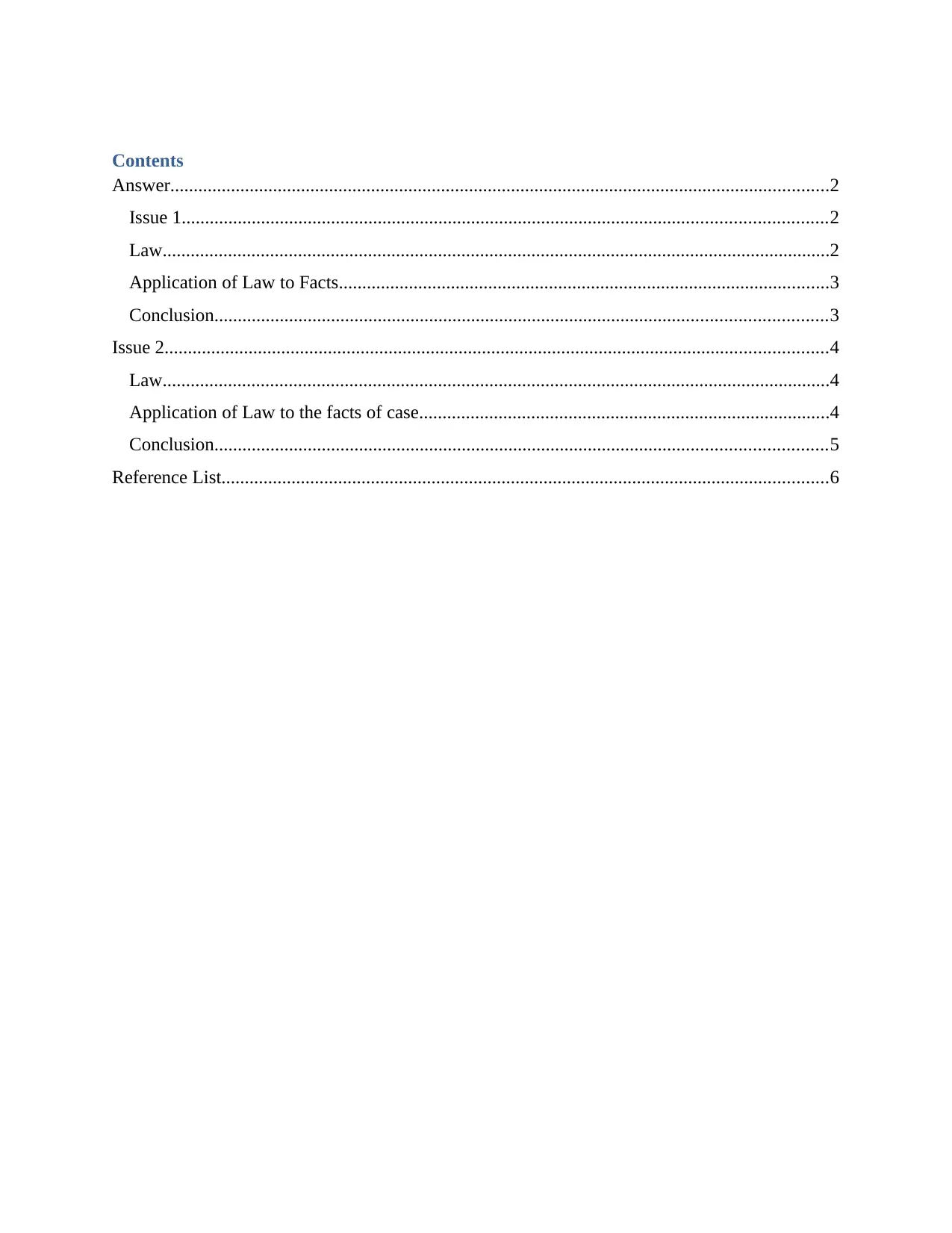
Contents
Answer.............................................................................................................................................2
Issue 1..........................................................................................................................................2
Law...............................................................................................................................................2
Application of Law to Facts.........................................................................................................3
Conclusion...................................................................................................................................3
Issue 2..............................................................................................................................................4
Law...............................................................................................................................................4
Application of Law to the facts of case........................................................................................4
Conclusion...................................................................................................................................5
Reference List..................................................................................................................................6
Answer.............................................................................................................................................2
Issue 1..........................................................................................................................................2
Law...............................................................................................................................................2
Application of Law to Facts.........................................................................................................3
Conclusion...................................................................................................................................3
Issue 2..............................................................................................................................................4
Law...............................................................................................................................................4
Application of Law to the facts of case........................................................................................4
Conclusion...................................................................................................................................5
Reference List..................................................................................................................................6
Paraphrase This Document
Need a fresh take? Get an instant paraphrase of this document with our AI Paraphraser
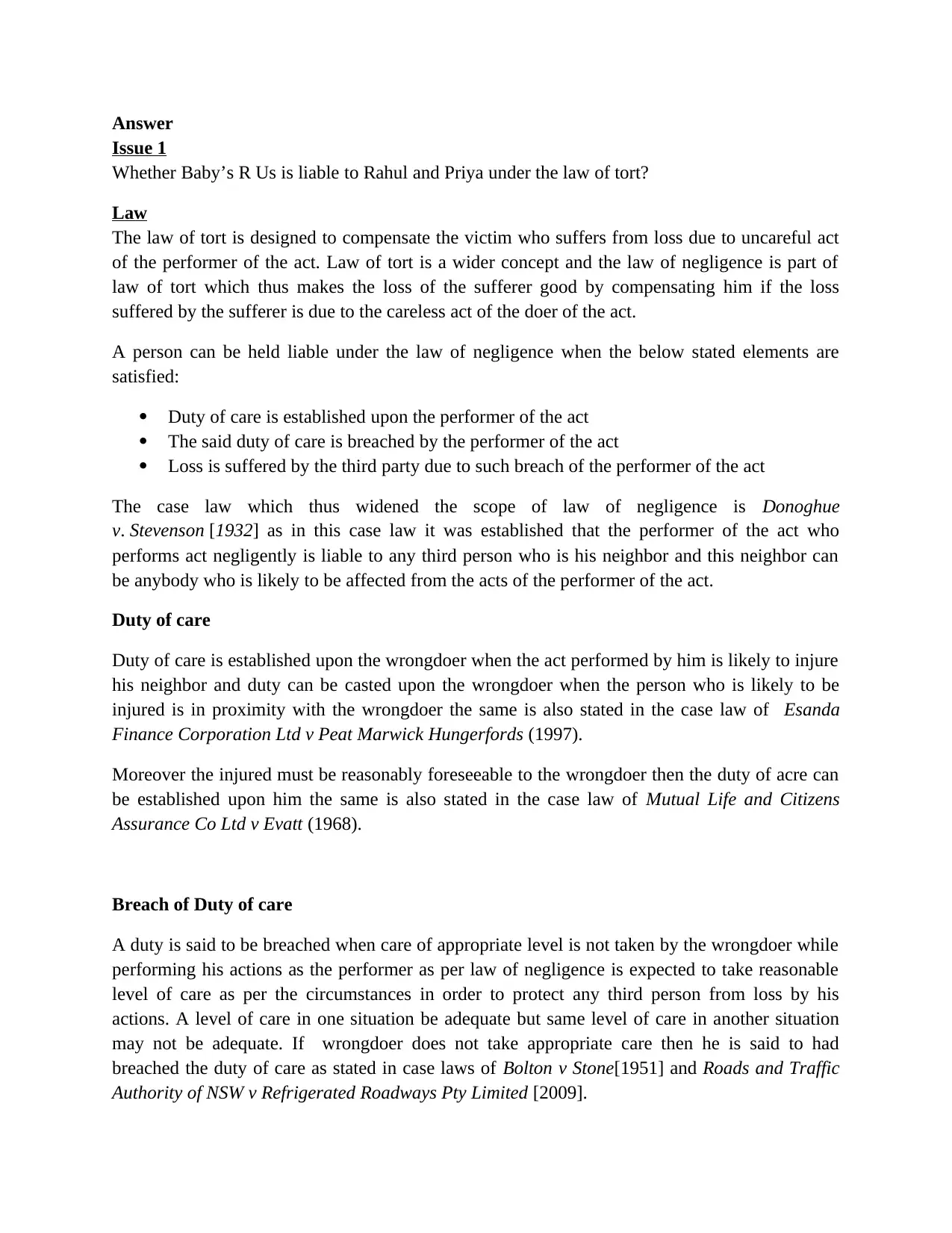
Answer
Issue 1
Whether Baby’s R Us is liable to Rahul and Priya under the law of tort?
Law
The law of tort is designed to compensate the victim who suffers from loss due to uncareful act
of the performer of the act. Law of tort is a wider concept and the law of negligence is part of
law of tort which thus makes the loss of the sufferer good by compensating him if the loss
suffered by the sufferer is due to the careless act of the doer of the act.
A person can be held liable under the law of negligence when the below stated elements are
satisfied:
Duty of care is established upon the performer of the act
The said duty of care is breached by the performer of the act
Loss is suffered by the third party due to such breach of the performer of the act
The case law which thus widened the scope of law of negligence is Donoghue
v. Stevenson [1932] as in this case law it was established that the performer of the act who
performs act negligently is liable to any third person who is his neighbor and this neighbor can
be anybody who is likely to be affected from the acts of the performer of the act.
Duty of care
Duty of care is established upon the wrongdoer when the act performed by him is likely to injure
his neighbor and duty can be casted upon the wrongdoer when the person who is likely to be
injured is in proximity with the wrongdoer the same is also stated in the case law of Esanda
Finance Corporation Ltd v Peat Marwick Hungerfords (1997).
Moreover the injured must be reasonably foreseeable to the wrongdoer then the duty of acre can
be established upon him the same is also stated in the case law of Mutual Life and Citizens
Assurance Co Ltd v Evatt (1968).
Breach of Duty of care
A duty is said to be breached when care of appropriate level is not taken by the wrongdoer while
performing his actions as the performer as per law of negligence is expected to take reasonable
level of care as per the circumstances in order to protect any third person from loss by his
actions. A level of care in one situation be adequate but same level of care in another situation
may not be adequate. If wrongdoer does not take appropriate care then he is said to had
breached the duty of care as stated in case laws of Bolton v Stone[1951] and Roads and Traffic
Authority of NSW v Refrigerated Roadways Pty Limited [2009].
Issue 1
Whether Baby’s R Us is liable to Rahul and Priya under the law of tort?
Law
The law of tort is designed to compensate the victim who suffers from loss due to uncareful act
of the performer of the act. Law of tort is a wider concept and the law of negligence is part of
law of tort which thus makes the loss of the sufferer good by compensating him if the loss
suffered by the sufferer is due to the careless act of the doer of the act.
A person can be held liable under the law of negligence when the below stated elements are
satisfied:
Duty of care is established upon the performer of the act
The said duty of care is breached by the performer of the act
Loss is suffered by the third party due to such breach of the performer of the act
The case law which thus widened the scope of law of negligence is Donoghue
v. Stevenson [1932] as in this case law it was established that the performer of the act who
performs act negligently is liable to any third person who is his neighbor and this neighbor can
be anybody who is likely to be affected from the acts of the performer of the act.
Duty of care
Duty of care is established upon the wrongdoer when the act performed by him is likely to injure
his neighbor and duty can be casted upon the wrongdoer when the person who is likely to be
injured is in proximity with the wrongdoer the same is also stated in the case law of Esanda
Finance Corporation Ltd v Peat Marwick Hungerfords (1997).
Moreover the injured must be reasonably foreseeable to the wrongdoer then the duty of acre can
be established upon him the same is also stated in the case law of Mutual Life and Citizens
Assurance Co Ltd v Evatt (1968).
Breach of Duty of care
A duty is said to be breached when care of appropriate level is not taken by the wrongdoer while
performing his actions as the performer as per law of negligence is expected to take reasonable
level of care as per the circumstances in order to protect any third person from loss by his
actions. A level of care in one situation be adequate but same level of care in another situation
may not be adequate. If wrongdoer does not take appropriate care then he is said to had
breached the duty of care as stated in case laws of Bolton v Stone[1951] and Roads and Traffic
Authority of NSW v Refrigerated Roadways Pty Limited [2009].
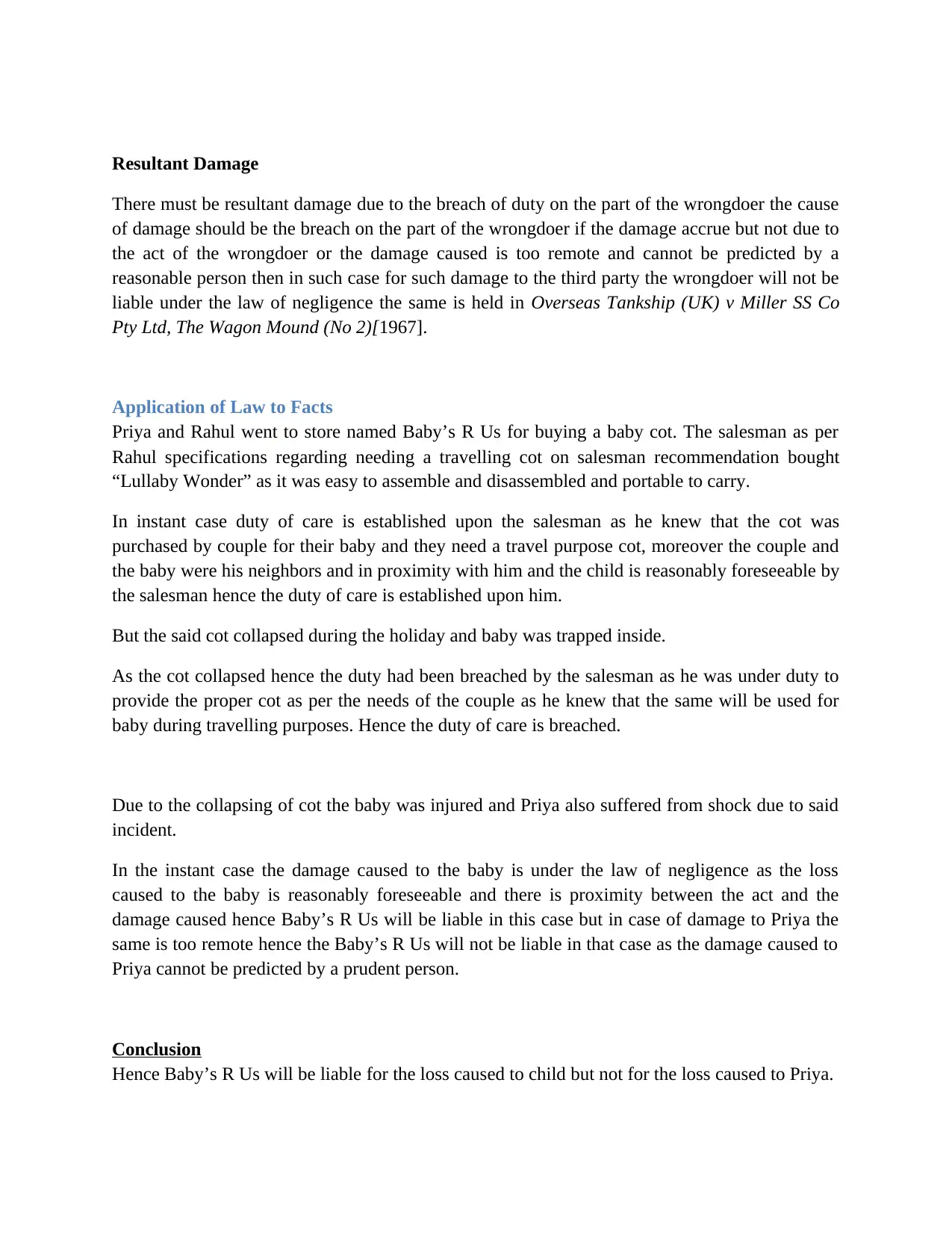
Resultant Damage
There must be resultant damage due to the breach of duty on the part of the wrongdoer the cause
of damage should be the breach on the part of the wrongdoer if the damage accrue but not due to
the act of the wrongdoer or the damage caused is too remote and cannot be predicted by a
reasonable person then in such case for such damage to the third party the wrongdoer will not be
liable under the law of negligence the same is held in Overseas Tankship (UK) v Miller SS Co
Pty Ltd, The Wagon Mound (No 2)[1967].
Application of Law to Facts
Priya and Rahul went to store named Baby’s R Us for buying a baby cot. The salesman as per
Rahul specifications regarding needing a travelling cot on salesman recommendation bought
“Lullaby Wonder” as it was easy to assemble and disassembled and portable to carry.
In instant case duty of care is established upon the salesman as he knew that the cot was
purchased by couple for their baby and they need a travel purpose cot, moreover the couple and
the baby were his neighbors and in proximity with him and the child is reasonably foreseeable by
the salesman hence the duty of care is established upon him.
But the said cot collapsed during the holiday and baby was trapped inside.
As the cot collapsed hence the duty had been breached by the salesman as he was under duty to
provide the proper cot as per the needs of the couple as he knew that the same will be used for
baby during travelling purposes. Hence the duty of care is breached.
Due to the collapsing of cot the baby was injured and Priya also suffered from shock due to said
incident.
In the instant case the damage caused to the baby is under the law of negligence as the loss
caused to the baby is reasonably foreseeable and there is proximity between the act and the
damage caused hence Baby’s R Us will be liable in this case but in case of damage to Priya the
same is too remote hence the Baby’s R Us will not be liable in that case as the damage caused to
Priya cannot be predicted by a prudent person.
Conclusion
Hence Baby’s R Us will be liable for the loss caused to child but not for the loss caused to Priya.
There must be resultant damage due to the breach of duty on the part of the wrongdoer the cause
of damage should be the breach on the part of the wrongdoer if the damage accrue but not due to
the act of the wrongdoer or the damage caused is too remote and cannot be predicted by a
reasonable person then in such case for such damage to the third party the wrongdoer will not be
liable under the law of negligence the same is held in Overseas Tankship (UK) v Miller SS Co
Pty Ltd, The Wagon Mound (No 2)[1967].
Application of Law to Facts
Priya and Rahul went to store named Baby’s R Us for buying a baby cot. The salesman as per
Rahul specifications regarding needing a travelling cot on salesman recommendation bought
“Lullaby Wonder” as it was easy to assemble and disassembled and portable to carry.
In instant case duty of care is established upon the salesman as he knew that the cot was
purchased by couple for their baby and they need a travel purpose cot, moreover the couple and
the baby were his neighbors and in proximity with him and the child is reasonably foreseeable by
the salesman hence the duty of care is established upon him.
But the said cot collapsed during the holiday and baby was trapped inside.
As the cot collapsed hence the duty had been breached by the salesman as he was under duty to
provide the proper cot as per the needs of the couple as he knew that the same will be used for
baby during travelling purposes. Hence the duty of care is breached.
Due to the collapsing of cot the baby was injured and Priya also suffered from shock due to said
incident.
In the instant case the damage caused to the baby is under the law of negligence as the loss
caused to the baby is reasonably foreseeable and there is proximity between the act and the
damage caused hence Baby’s R Us will be liable in this case but in case of damage to Priya the
same is too remote hence the Baby’s R Us will not be liable in that case as the damage caused to
Priya cannot be predicted by a prudent person.
Conclusion
Hence Baby’s R Us will be liable for the loss caused to child but not for the loss caused to Priya.
⊘ This is a preview!⊘
Do you want full access?
Subscribe today to unlock all pages.

Trusted by 1+ million students worldwide
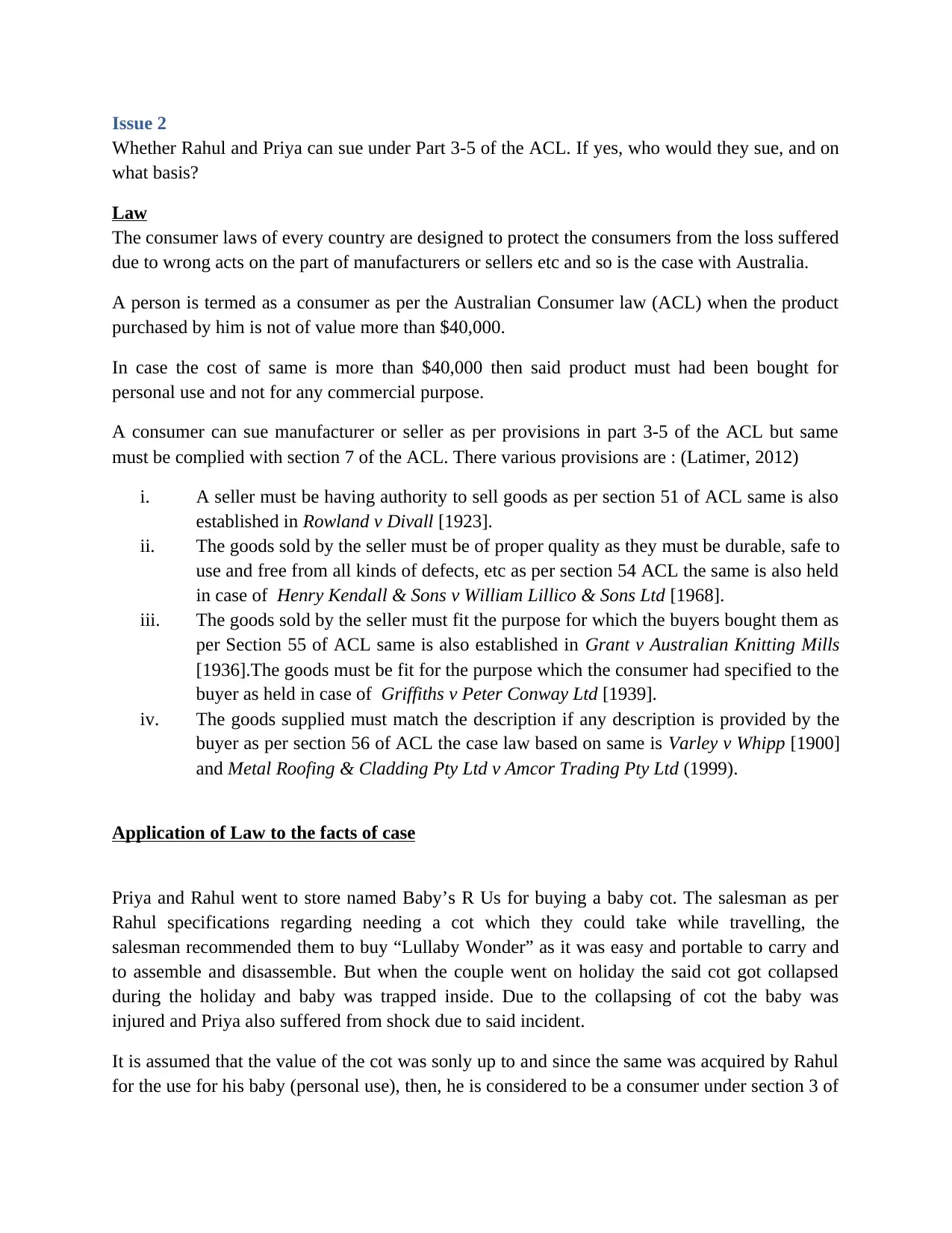
Issue 2
Whether Rahul and Priya can sue under Part 3-5 of the ACL. If yes, who would they sue, and on
what basis?
Law
The consumer laws of every country are designed to protect the consumers from the loss suffered
due to wrong acts on the part of manufacturers or sellers etc and so is the case with Australia.
A person is termed as a consumer as per the Australian Consumer law (ACL) when the product
purchased by him is not of value more than $40,000.
In case the cost of same is more than $40,000 then said product must had been bought for
personal use and not for any commercial purpose.
A consumer can sue manufacturer or seller as per provisions in part 3-5 of the ACL but same
must be complied with section 7 of the ACL. There various provisions are : (Latimer, 2012)
i. A seller must be having authority to sell goods as per section 51 of ACL same is also
established in Rowland v Divall [1923].
ii. The goods sold by the seller must be of proper quality as they must be durable, safe to
use and free from all kinds of defects, etc as per section 54 ACL the same is also held
in case of Henry Kendall & Sons v William Lillico & Sons Ltd [1968].
iii. The goods sold by the seller must fit the purpose for which the buyers bought them as
per Section 55 of ACL same is also established in Grant v Australian Knitting Mills
[1936].The goods must be fit for the purpose which the consumer had specified to the
buyer as held in case of Griffiths v Peter Conway Ltd [1939].
iv. The goods supplied must match the description if any description is provided by the
buyer as per section 56 of ACL the case law based on same is Varley v Whipp [1900]
and Metal Roofing & Cladding Pty Ltd v Amcor Trading Pty Ltd (1999).
Application of Law to the facts of case
Priya and Rahul went to store named Baby’s R Us for buying a baby cot. The salesman as per
Rahul specifications regarding needing a cot which they could take while travelling, the
salesman recommended them to buy “Lullaby Wonder” as it was easy and portable to carry and
to assemble and disassemble. But when the couple went on holiday the said cot got collapsed
during the holiday and baby was trapped inside. Due to the collapsing of cot the baby was
injured and Priya also suffered from shock due to said incident.
It is assumed that the value of the cot was sonly up to and since the same was acquired by Rahul
for the use for his baby (personal use), then, he is considered to be a consumer under section 3 of
Whether Rahul and Priya can sue under Part 3-5 of the ACL. If yes, who would they sue, and on
what basis?
Law
The consumer laws of every country are designed to protect the consumers from the loss suffered
due to wrong acts on the part of manufacturers or sellers etc and so is the case with Australia.
A person is termed as a consumer as per the Australian Consumer law (ACL) when the product
purchased by him is not of value more than $40,000.
In case the cost of same is more than $40,000 then said product must had been bought for
personal use and not for any commercial purpose.
A consumer can sue manufacturer or seller as per provisions in part 3-5 of the ACL but same
must be complied with section 7 of the ACL. There various provisions are : (Latimer, 2012)
i. A seller must be having authority to sell goods as per section 51 of ACL same is also
established in Rowland v Divall [1923].
ii. The goods sold by the seller must be of proper quality as they must be durable, safe to
use and free from all kinds of defects, etc as per section 54 ACL the same is also held
in case of Henry Kendall & Sons v William Lillico & Sons Ltd [1968].
iii. The goods sold by the seller must fit the purpose for which the buyers bought them as
per Section 55 of ACL same is also established in Grant v Australian Knitting Mills
[1936].The goods must be fit for the purpose which the consumer had specified to the
buyer as held in case of Griffiths v Peter Conway Ltd [1939].
iv. The goods supplied must match the description if any description is provided by the
buyer as per section 56 of ACL the case law based on same is Varley v Whipp [1900]
and Metal Roofing & Cladding Pty Ltd v Amcor Trading Pty Ltd (1999).
Application of Law to the facts of case
Priya and Rahul went to store named Baby’s R Us for buying a baby cot. The salesman as per
Rahul specifications regarding needing a cot which they could take while travelling, the
salesman recommended them to buy “Lullaby Wonder” as it was easy and portable to carry and
to assemble and disassemble. But when the couple went on holiday the said cot got collapsed
during the holiday and baby was trapped inside. Due to the collapsing of cot the baby was
injured and Priya also suffered from shock due to said incident.
It is assumed that the value of the cot was sonly up to and since the same was acquired by Rahul
for the use for his baby (personal use), then, he is considered to be a consumer under section 3 of
Paraphrase This Document
Need a fresh take? Get an instant paraphrase of this document with our AI Paraphraser
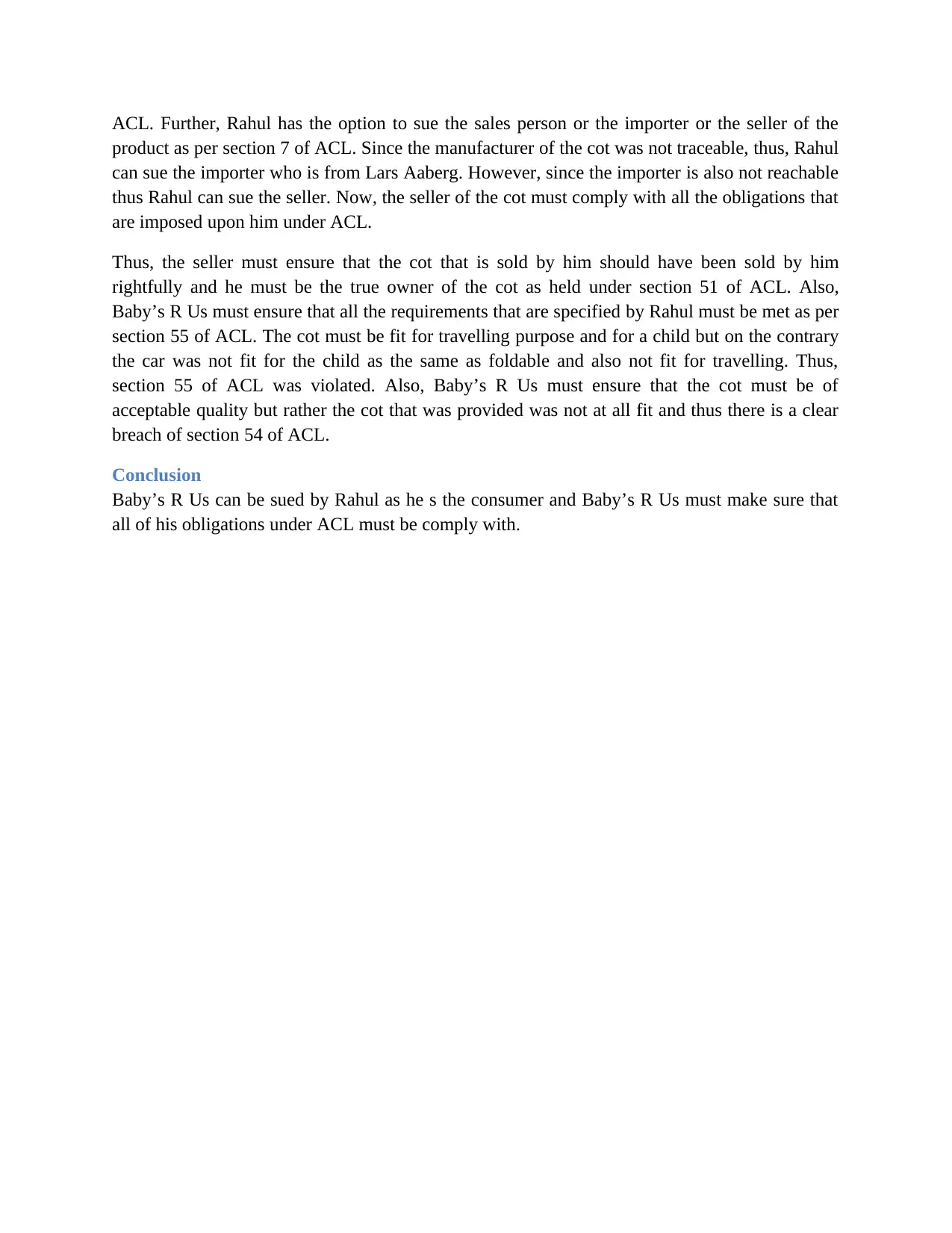
ACL. Further, Rahul has the option to sue the sales person or the importer or the seller of the
product as per section 7 of ACL. Since the manufacturer of the cot was not traceable, thus, Rahul
can sue the importer who is from Lars Aaberg. However, since the importer is also not reachable
thus Rahul can sue the seller. Now, the seller of the cot must comply with all the obligations that
are imposed upon him under ACL.
Thus, the seller must ensure that the cot that is sold by him should have been sold by him
rightfully and he must be the true owner of the cot as held under section 51 of ACL. Also,
Baby’s R Us must ensure that all the requirements that are specified by Rahul must be met as per
section 55 of ACL. The cot must be fit for travelling purpose and for a child but on the contrary
the car was not fit for the child as the same as foldable and also not fit for travelling. Thus,
section 55 of ACL was violated. Also, Baby’s R Us must ensure that the cot must be of
acceptable quality but rather the cot that was provided was not at all fit and thus there is a clear
breach of section 54 of ACL.
Conclusion
Baby’s R Us can be sued by Rahul as he s the consumer and Baby’s R Us must make sure that
all of his obligations under ACL must be comply with.
product as per section 7 of ACL. Since the manufacturer of the cot was not traceable, thus, Rahul
can sue the importer who is from Lars Aaberg. However, since the importer is also not reachable
thus Rahul can sue the seller. Now, the seller of the cot must comply with all the obligations that
are imposed upon him under ACL.
Thus, the seller must ensure that the cot that is sold by him should have been sold by him
rightfully and he must be the true owner of the cot as held under section 51 of ACL. Also,
Baby’s R Us must ensure that all the requirements that are specified by Rahul must be met as per
section 55 of ACL. The cot must be fit for travelling purpose and for a child but on the contrary
the car was not fit for the child as the same as foldable and also not fit for travelling. Thus,
section 55 of ACL was violated. Also, Baby’s R Us must ensure that the cot must be of
acceptable quality but rather the cot that was provided was not at all fit and thus there is a clear
breach of section 54 of ACL.
Conclusion
Baby’s R Us can be sued by Rahul as he s the consumer and Baby’s R Us must make sure that
all of his obligations under ACL must be comply with.
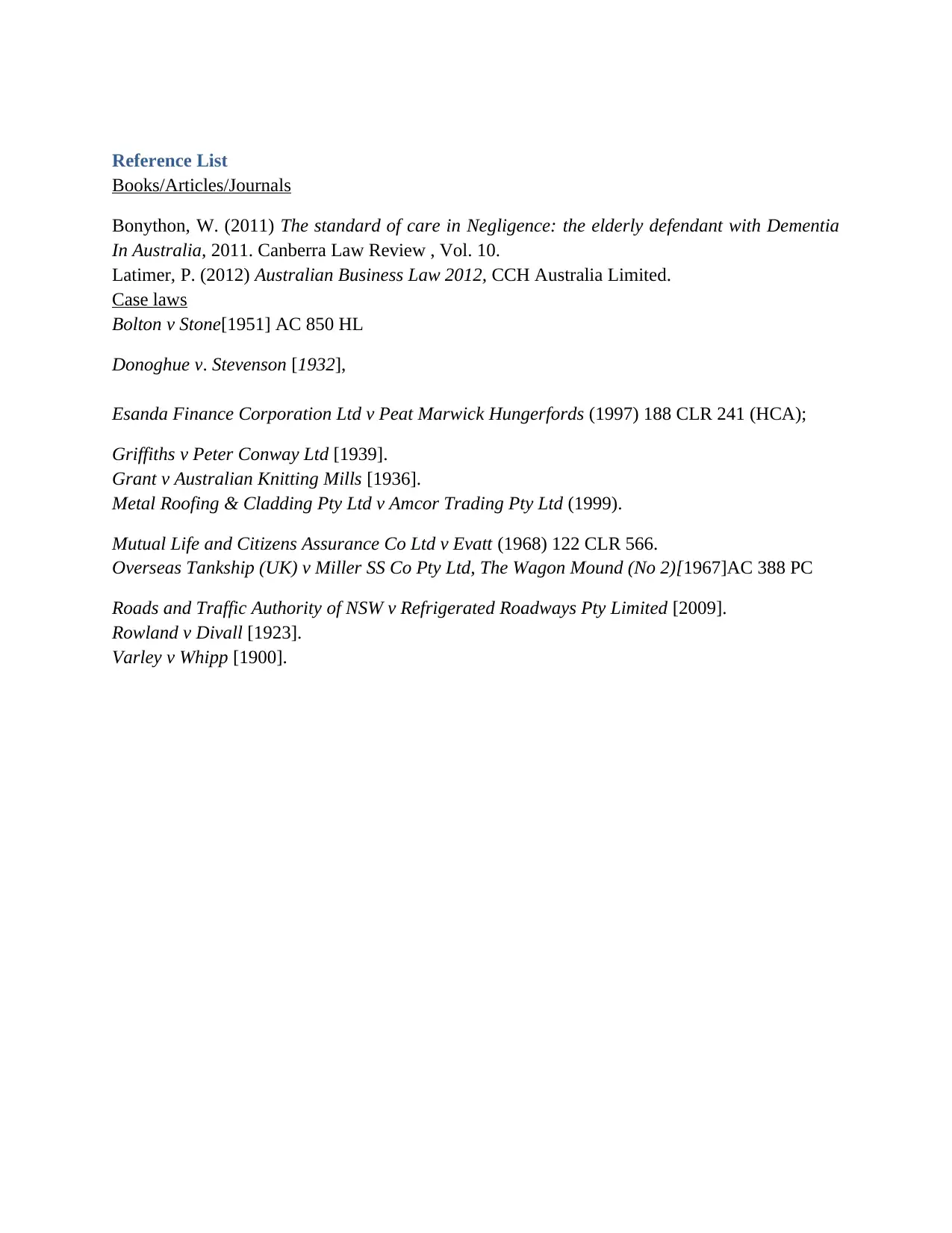
Reference List
Books/Articles/Journals
Bonython, W. (2011) The standard of care in Negligence: the elderly defendant with Dementia
In Australia, 2011. Canberra Law Review , Vol. 10.
Latimer, P. (2012) Australian Business Law 2012, CCH Australia Limited.
Case laws
Bolton v Stone[1951] AC 850 HL
Donoghue v. Stevenson [1932],
Esanda Finance Corporation Ltd v Peat Marwick Hungerfords (1997) 188 CLR 241 (HCA);
Griffiths v Peter Conway Ltd [1939].
Grant v Australian Knitting Mills [1936].
Metal Roofing & Cladding Pty Ltd v Amcor Trading Pty Ltd (1999).
Mutual Life and Citizens Assurance Co Ltd v Evatt (1968) 122 CLR 566.
Overseas Tankship (UK) v Miller SS Co Pty Ltd, The Wagon Mound (No 2)[1967]AC 388 PC
Roads and Traffic Authority of NSW v Refrigerated Roadways Pty Limited [2009].
Rowland v Divall [1923].
Varley v Whipp [1900].
Books/Articles/Journals
Bonython, W. (2011) The standard of care in Negligence: the elderly defendant with Dementia
In Australia, 2011. Canberra Law Review , Vol. 10.
Latimer, P. (2012) Australian Business Law 2012, CCH Australia Limited.
Case laws
Bolton v Stone[1951] AC 850 HL
Donoghue v. Stevenson [1932],
Esanda Finance Corporation Ltd v Peat Marwick Hungerfords (1997) 188 CLR 241 (HCA);
Griffiths v Peter Conway Ltd [1939].
Grant v Australian Knitting Mills [1936].
Metal Roofing & Cladding Pty Ltd v Amcor Trading Pty Ltd (1999).
Mutual Life and Citizens Assurance Co Ltd v Evatt (1968) 122 CLR 566.
Overseas Tankship (UK) v Miller SS Co Pty Ltd, The Wagon Mound (No 2)[1967]AC 388 PC
Roads and Traffic Authority of NSW v Refrigerated Roadways Pty Limited [2009].
Rowland v Divall [1923].
Varley v Whipp [1900].
⊘ This is a preview!⊘
Do you want full access?
Subscribe today to unlock all pages.

Trusted by 1+ million students worldwide
1 out of 6
Related Documents
Your All-in-One AI-Powered Toolkit for Academic Success.
+13062052269
info@desklib.com
Available 24*7 on WhatsApp / Email
![[object Object]](/_next/static/media/star-bottom.7253800d.svg)
Unlock your academic potential
Copyright © 2020–2025 A2Z Services. All Rights Reserved. Developed and managed by ZUCOL.





